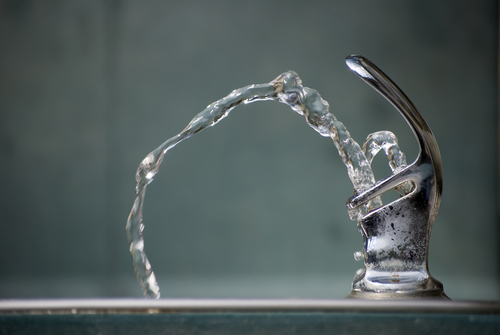Whether you’re a facilities manager planning new construction, performing a renovation project, or simply ensuring your facility is following the law, it is important to make sure that your drinking fountains are compliant with the federal Americans with Disabilities Act (ADA).

The experts at Haws Corp. recently covered the ins and outs of compliance during a webinar. Presenters from the company included Justin Dunn, Senior Field Marketing Specialist, and Hayden Del Dotto, Field Marketing Specialist. Dunn advised double-checking state and local laws as well, because they might be stricter than those of the federal government.
Numbers
ADA requirements specify that there be at least:
- Two drinking fountains, based on occupancy per local building code
- One high-side fountain
- One low-side fountain
- 50% of fountains must be high-side, and the other half must be low-side, but if there is a fraction, the last fountain can be low or high
“What most people don’t understand is that the low-side fountain is not the only one that’s designed for people with disabilities,” said Dunn. “The high-side fountain is also a disabled-accessible fountain designed for those with bending or stooping disabilities that may be using a walker, cane, crutches, and may not be physically able to utilize the low-side fountain.”
Low-side drinking fountains are designed for those using a wheelchair.
Dimensional and Mechanical Requirements
Ground space should be unobstructed and measure 30″ minimum by 48″ minimum clearance underneath the drinking fountain. This is a bit larger than the typical adult-sized wheelchair. The space must allow a forward or a parallel approach.
Dunn reminded facilities professionals that these are minimum requirements and that the more space they can provide, the better.
Alcoves
Many facilities have drinking fountains in alcoves, which are recessed areas off hallways outside of the path of travel.
Federal ADA law does not require alcoves, but facilities that have them must meet minimum floor space requirements so that additional maneuvering space is provided for those with disabilities. Clear floor space is dependent on the depth of the alcove and type of the approach.
“In our first example, our 30 by 48 inches becomes 36 by 48 inches when the depth of the alcove exceeds two feet, 24 inches,” explained Dunn. “In the second example for a parallel approach when the depth of the alcove exceeds 15 inches, then our clear floor space must be 30 by 60 inches.”
According to Del Dotto, some states that require alcoves in facilities include California, Texas, Connecticut, and Georgia.
“This is to make sure drinking fountains are not protruding into any pedestrian walkways or paths of travel,” he explained.
Toe and Knee Clearance
Facilities professionals should keep the following in mind:
- Toe clearance: 9” between the ground and the bottom of the unit
- Knee clearance: 27” above the ground
“The space underneath has to be clear, and that includes any space between the knees and that includes T-traps, hanging phone books, anything else you can think of, but this entire space is unusable,” explained Dunn.
Importance of Clear Floor Space
Dunn said that the floor space should be centered on the low side, as this is intended for the wheelchair user.
He noted, “Many make the mistake of centering the clear floor space on the alcove, which is a huge mistake and ends up leading to expensive tear-outs and redesigns of the alcove and of the space.”
Protruding Objects
To provide safety to those who are visually impaired, the ADA requires that all objects with leading edges between 27” and 80” above the floor not protrude more than 4” horizontally into the walkway. If a person is using a cane, there would be enough time to detect the element with the cane before there is body contact.
Dunn said that drinking fountains not in an alcove can utilize a cane touch skirt to bring the high-side fountain’s lower edge down to 27” above the finished floor so that it can be detected by a cane.
Reach Ranges
When the forward reach is unobstructed for buttons, handles, and sensors, the high forward reach should be 48” maximum and 15” minimum.
For obstructed high reaches, there is a:
- 48” maximum when reach depth is 20” maximum
- 44” maximum when reach depth is 20-25” maximum
Children
Children with disabilities should also be accommodated with appropriate size drinking fountains in schools and daycares where there are many children.
- Ages 3-4: Maximum 36”, minimum 20”
- Ages 5-8: Maximum 40”, minimum 18”
- Ages 9-12: Maximum 44”, minimum 16”
Note that designing a drinking fountain with a parallel approach, the spout can be no higher than 30″ above the floor and no more than 3.5” from the front edge of the unit to the spout.
Learn More
To learn more about drinking fountain installations, including the ability to view schematic drawings, photos of recommended installations, and those to avoid, as well as information regarding outdoor drinking fountain and bottle filler installations, please watch the entire Haws webinar by clicking here. Be aware that bottle fillers cannot be installed to substitute for drinking fountains.
